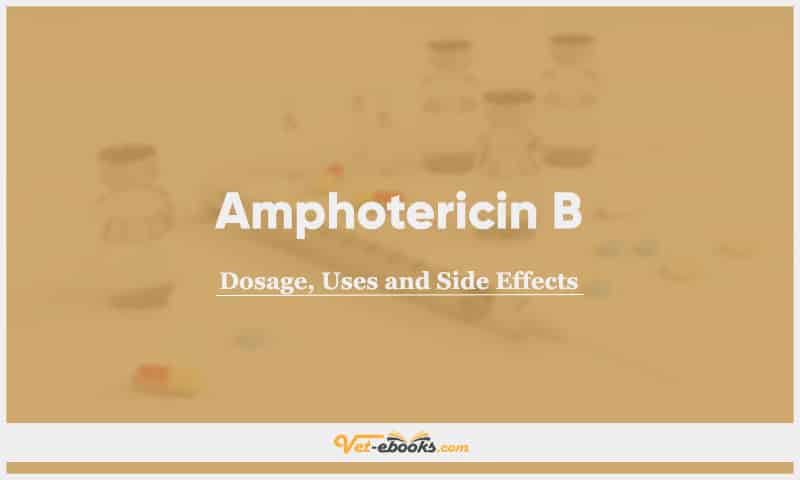Amphotericin B For Dogs, Cats and Other Animals: Uses, Dosage, and Side Effects Guide

Overview
- It binds to sterols in fungal cell membrane creating pores and allowing leakage of contents.
- 50 mg/vial powder for reconstitution.
Uses of Amphotericin B
- Systemic fungal infections (e.g., Blastomycosis, Cryptococcosis, Coccidioidomycosis, Histoplasmosis).
- Leishmaniasis (use is discouraged to prevent resistance in human treatments).
- Bladder irrigation for fungal infections in dogs.
- Intralesional treatment for localized infections.
Dose of Amphotericin B
Dogs
- Systemic Mycoses (Conventional Amphotericin):
- Dose: 0.25–1 mg/kg IV q48h, administered slowly over 4–6 hours.
- Reconstitution: Add 10 mL sterile water to the vial (5 mg/mL solution); dilute 1:50 with 5% dextrose to achieve a 0.1 mg/mL solution.
- Alternative Administration: Dissolve 0.25–1 mg/kg in 10–60 mL of 5% dextrose and administer over 10 minutes, 3 times weekly.
- Duration: Several months of therapy are often necessary. Start at the lower end of the dose range and gradually increase as tolerated.
- Dose: 0.25–1 mg/kg IV q48h, administered slowly over 4–6 hours.
- Cryptococcosis (Subcutaneous Alternative):
- Dose: 0.5–0.8 mg/kg added to 400–500 mL of 0.45% saline/2.5% dextrose.
- Administer this total volume SC 2–3 times weekly to a cumulative dose of 8–26 mg/kg.
- Concentration Limit: Do not inject solutions more concentrated than 20 mg/L to avoid subcutaneous abscesses.
- Intralesional Treatment: 1 mg/kg intralesional injection every 7 days, combined with oral itraconazole.
- Dose: 0.5–0.8 mg/kg added to 400–500 mL of 0.45% saline/2.5% dextrose.
- Bladder Irrigation (Conventional Amphotericin):
- Dose: 30–50 mg in 50–100 mL of sterile water, infused at 5–10 mL/kg into the bladder daily for 5–15 days.
- Systemic Mycoses (Lipid Formulations):
- Dose: 1 mg/kg IV q48h to a cumulative dose of 12 mg/kg.
- Higher Doses Tolerated: 1–2.5 mg/kg IV q48h for 4 weeks or to a cumulative dose of 24–30 mg/kg.
- Reconstitution: Add sterile water (5 mg/mL solution), dilute further to 1 mg/mL with 5% dextrose.
- Leishmaniasis (Lipid Formulations):
- Dose: 1–2.5 mg/kg IV twice weekly for 8 injections.
- Cumulative Dose: At least 10 mg/kg is required but may continue long-term depending on clinical response. Gradually increase the dose.
Cats
- Systemic Mycoses (Conventional Amphotericin):
- Dose: 0.1–0.25 mg/kg IV q48h.
- Details: Follow the same reconstitution and dilution procedures as for dogs.
- Duration: Several months of therapy, depending on clinical response.
- Dose: 0.1–0.25 mg/kg IV q48h.
- Cryptococcosis (Subcutaneous Alternative):
- Dose: 0.5–0.8 mg/kg added to 400–500 mL of 0.45% saline/2.5% dextrose.
- Administer SC 2–3 times weekly to a cumulative dose of 10–15 mg/kg.
- Intralesional Treatment: 1 mg/kg intralesional injection every 7 days, combined with oral itraconazole.
- Dose: 0.5–0.8 mg/kg added to 400–500 mL of 0.45% saline/2.5% dextrose.
- Systemic Mycoses (Lipid Formulations):
- Dose: 1 mg/kg IV q48h to a cumulative dose of 12 mg/kg.
- Higher Doses Tolerated: 1–2.5 mg/kg IV q48h for 4 weeks or to a cumulative dose of 24–30 mg/kg.
Horses
- Systemic Mycoses (Conventional Amphotericin):
- Dose: Start with 0.3 mg/kg IV in 1 L of 5% dextrose over 1 hour.
- Gradually increase the dose by 0.1–0.15 mg/kg daily for the next 2 days.
- Maintenance Dose: 0.5–0.6 mg/kg IV every 2–3 days for up to 1 month or until a cumulative dose of 6.75 mg/kg is reached.
- Dose: Start with 0.3 mg/kg IV in 1 L of 5% dextrose over 1 hour.
- Limb Pythiosis (Regional Limb Perfusion):
- Dose: 50 mg diluted in 50 mL LRS, administered into the affected limb via IV regional limb perfusion.
- Apply a tourniquet above the injection site and remove after 45 minutes.
- Repeat after 14 days if necessary.
- Dose: 50 mg diluted in 50 mL LRS, administered into the affected limb via IV regional limb perfusion.
- Fungal Endometritis:
- Dose: 200–250 mg (NOT mg/kg) intrauterine infusion daily or every other day for 3–7 days.
Birds
- Systemic Mycoses (Conventional Amphotericin):
- Dose: 1.5 mg/kg IV q12h for 3–5 days.
- Alternative Routes: 1 mg/kg intratracheally q12h or 0.3–1 mg/mL nebulized for 15 minutes 2–4 times daily.
- Dose: 1.5 mg/kg IV q12h for 3–5 days.
- Aspergillosis (Psittacines and Raptors):
- Dose: 1.5 mg/kg IV q8h for 3 days, followed by flucytosine.
- Intratracheal alternative: 1 mg/kg diluted in sterile water q8–24h for 3 days.
- Dose: 1.5 mg/kg IV q8h for 3 days, followed by flucytosine.
- Macrorhabdiasis:
- Dose: 100–150 mg/kg PO q12h for 30 days.
Rabbits
- Systemic Mycoses (Conventional Amphotericin):
- Dose: 1 mg/kg/day IV.
Reptiles
- Fungal Respiratory Infections (Conventional Amphotericin):
- Dose: 1 mg/kg diluted in saline, given intratracheally q24h for 14–28 treatments.
Drug Dosage Calculator
You Should Give:
Side Effects of Amphotericin B in Dogs and Cats
- Common: Vomiting, diarrhea, pyrexia (fever), hypokalemia, phlebitis, and renal failure.
- Rare: Hepatic failure, anaphylactic reactions, tachycardia, and arrhythmias.
- Specific: Subcutaneous abscesses (if concentration >20 mg/L).
Contraindications of Amphotericin B
- Avoid in patients with severe renal or hepatic failure.
- Use cautiously with nephrotoxic medications.
Some Notes:
- Nephrotoxicity Management:
- Administer pre- and post-infusion fluids, such as saline or lactated Ringer’s (5 mL/kg/hr), 30 minutes before and 120 minutes after amphotericin B administration to mitigate nephrotoxicity.
- Ensure IV lines are thoroughly flushed with 5% dextrose water before and after amphotericin B administration.
- Gradual Dose Adjustment:
- Start with the lowest recommended dose and increase gradually based on the patient’s tolerance to minimize adverse effects.
- Monitoring Requirements:
- Conduct regular renal function tests (serum creatinine, BUN) and monitor electrolytes (potassium, magnesium). Discontinue treatment if BUN > 30–40 mg/dL or serum creatinine > 3 mg/dL.
- Assess for infusion-related reactions, including phlebitis, tachycardia, and hypotension.
- Drug Interactions:
- Avoid co-administration with nephrotoxic drugs (e.g., aminoglycosides, NSAIDs, cisplatin) to prevent compounded renal damage.
- Use caution with potassium-depleting drugs (e.g., loop or thiazide diuretics), as they may exacerbate amphotericin B-induced hypokalemia.
- Monitor closely for digoxin toxicity when co-administered, as hypokalemia can increase its risk.
- Pre-Treatment for Side Effects:
- Use aspirin, diphenhydramine, or an antiemetic to reduce fever, vomiting, and infusion-related adverse effects.
- Opt for slow infusion rates or lipid formulations to lower nephrotoxicity risk.
- Compatibility Notes:
- Do not mix amphotericin B with sodium chloride or electrolyte-containing solutions to avoid precipitation.
- Always use 5% dextrose water for dilution and administration. Lipid formulations are also incompatible with saline solutions.
- Special Precautions:
- Amphotericin B should be used cautiously in patients with pre-existing renal or hepatic disease, and only when necessary in pregnant or nursing animals.
- Regular weight monitoring and hydration checks are essential in exotic species.
- Resistance Considerations:
- Avoid amphotericin B for leishmaniasis in dogs, as it may contribute to resistance in human treatment protocols, per WHO recommendations.
- Long-Term Therapy:
- Therapy duration for systemic fungal infections may extend over several months. Adjust cumulative doses based on clinical response and toxicity thresholds.
- Storage Guidelines:
- Store conventional amphotericin B powder at 2°C–8°C (36°F–46°F), protected from light and moisture. Use reconstituted solutions within 7 days.
- Follow specific storage and stability recommendations for lipid formulations per the manufacturer’s guidelines.
- Exotics and Amphotericin B:
- In birds, amphotericin B shows reduced nephrotoxicity but may cause myelosuppression. Intratracheal and nebulized routes are common for respiratory infections.
- Reptiles tolerate intratracheal doses well; sterile preparation is critical for these routes.
Tip
Do You Want To Increase Your Veterinary Knowledge and Practical Skills?
You Can Now Browse and Download +3000 Books For Veterinary Professionals & Students Online.
Download Veterinary Books




















